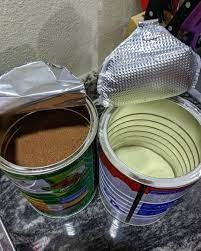Why Does Milk Finish before Milo?
Why Does Milk Finish before Milo? Please Watch >>>>
- “Explain Why Milk Always finishes before Milo?”- see funny reactions to this Question on Facebook.
- Opinion: Why Does Peak Milk Always Finish Before The Milo?
- Why Does The Milk Always Finish Before The Bournvita
- Opinion: Why Does Peak Milk Always Finish Before The Milo?
Why Does Milk Finish before Milo ~ THE VERDICT
The reason for this is that milk is used for everything, including cereal, pap, and oats, so it’s only natural that it finishes first.
Even Milo requires a lot of milk to give it the desired taste, and people use milk also for other things besides tea.
Why Does Milk Finish before Milo ~ an Overview

From the time I was a child until I became an adult, I had always wondered why my mother would buy two packs of milk and only one pack of Milo, yet at the end of the day, the Milk always finished first.
Is this a puzzle? Could this be one of the world’s wonders? Or is it just economics, demand, and supply?
Whatever the reason, the fact remains that in almost all Nigerian households, the Milk usually finishes before the Milo.
The Importance of Milk
Although cow milk is processed, it is not a genetically modified or fabricated food. It is approximately 87% water and 13% solids.
Fat-soluble vitamins are found in the milk’s fat portion. Proteins, carbohydrates, water-soluble vitamins, and minerals are examples of solids other than fat.
Milk contains these nutrients, which contribute to it being nature’s most nearly perfect food.
Milk contains high-quality proteins. Whey proteins account for approximately 18% of milk’s protein content.
All of the essential amino acids are found in casein, a protein found only in milk. It accounts for 82% of total protein in milk and is used to evaluate protein in other foods.
Protein is required for the formation of antibodies, which circulate in the blood and aid in the fight against infection.
The Nutritional Value of Milk in the Diet
Milk contains calcium, phosphorus, magnesium, and potassium, among other nutrients.
Milk contains calcium, which the body readily absorbs. Phosphorus aids calcium absorption and utilization. To form bone, phosphorus must be present in the proper ratio with calcium.
Milk contains these two minerals in roughly the same proportions as bone. Milk is also high in riboflavin (vitamin B2), which promotes healthy skin and eyes, as well as vitamins A and D.
In adults, calcium deficiency, combined with other factors, can lead to osteoporosis, or bone deterioration.
Calcium intake should be 1,000 milligrams per day for adults, 1,300 milligrams per day for adolescents, 500-800 milligrams per day for young children, and 1,200 milligrams per day for adults over the age of 51.
One serving of milk contains approximately 250 milligrams of calcium. Without milk and milk products in the diet, it is difficult to get enough calcium.
Milk and milk products provide approximately 73% of the calcium available in the food supply. The government’s U.S. Dietary Guidelines recommend the following daily consumption of milk group foods:
- For children aged 1 to 8, 2 servings
- For children aged 9 and up, 3 servings
- 3 servings per adult
Let us now look at the MILO that has been marginalized or underutilized.
MILO
Milo is a chocolate and malt powder that is mixed with hot or cold water or milk to make a popular beverage around the world.
The beverage, now manufactured by Nestlé, was invented in 1934 by Thomas Mayne in Sydney, Australia. It is marketed and sold in a variety of countries worldwide.
Milo is most commonly sold as a powder in a green tin depicting various sporting activities, but it is also available as a premixed beverage in some countries and has since evolved into a snack bar and breakfast cereal. Its composition and flavor vary by country.
The Nutritional Value of Milo
Milo contains 1,760 kJ (421 calories) per 100 g of powder, the majority of which comes from carbohydrates, primarily sugar.
The body can use carbohydrates for energy, which is why Milo is marketed as an energy drink.
Milo has the same Glycemic Index (GI) as Coca-Cola when dissolved in water. Milk, on the other hand, has a much lower GI of 30 – 33, so mixing a very small amount of Milo into a mug of milk yields an overall GI closer to 33 while mixing a large amount of Milo into a mug of milk yields an overall GI closer to 55.
Milo contains a lot of calcium, iron, and vitamins B1, B2, B6, and B12. Milo is marketed as containing “Actigen-E,” but this is simply Nestlé’s trademarked name for the vitamins found in the Milo recipe.
It also contains theobromine, a xanthine alkaloid similar to the caffeine found in the cocoa used in the product; thus, if consumed in quantities greater than 15 heaped teaspoons per day, it can become mildly addictive.
So, despite Milo’s high energy value, many people will still consume Milk before Milo, possibly because it tastes better
Common Questions on Why Does Milk Finish before Milo

How long does milo last?
To avoid this, always keep your lid properly sealed, store your MILO in a cool, dry place, and use it within 8 weeks of opening.
The Benefits of Drinking Milo before Bed
Malted milk is high in vitamin B, zinc, iron, phosphorous, and magnesium – a mineral combination that is ideal for helping you relax before bedtime.
How long does milo last in the fridge ~ how long can you keep MILO in the fridge?
Refrigerate milo in an airtight glass jar or container for 2-3 weeks.
Refrigeration is necessary to keep this fresh because the nuts and seeds must be kept chilled to avoid rancidity.
Is Milo safe to drink while pregnant? Is Milo good for a pregnant woman?
Don’t worry if you crave a Milo while pregnant. Milo can be consumed hot or cold; just try to keep the number of Milos to a minimum.
And don’t sweeten your Milo! If you’re watching your calories, try substituting cacao powder and a small amount of honey or coconut sugar for the Milo.
Is it safe for a pregnant woman to drink MILO or Bournvita?
Taking bournvita is not harmful.
What are the side effects of drinking MILO?
Milo will not satisfy your hunger because of its high sugar content.
Instead, it will simply stimulate your appetite and encourage you to continue eating.
As a result, if you consume a lot of sugar, you’ll just end up gaining more weight.
Is folic acid present in MILO?
Sugar, Cocoa, Barley Malt Extract (17%), Calcium Phosphate, Ferric Pyrophosphate, Calcium Ascorbate, Nicotinamide, Riboflavin, Thiamine Mononitrate, Retinyl Acetate, Folic Acid, Cholecalciferol.
Is MILO safe for a baby?
MILO can be consumed on a daily basis as part of a well-balanced diet that includes other nutritious foods and beverages.
It is also an excellent source of daily energy and nutrients for children. MILO is fortified with 6 vitamins and 3 minerals, which help children to grow and develop


